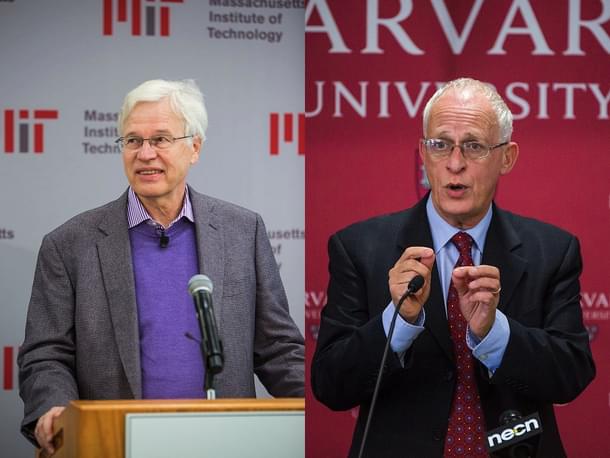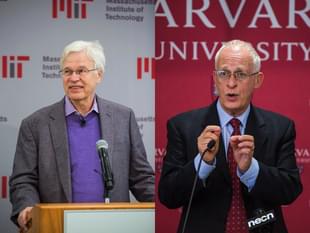Economics
Economics Nobel 2016: Why ‘Contracts’ Triumphed This Time
Aditya K
Oct 16, 2016, 11:55 AM | Updated 11:55 AM IST
Save & read from anywhere!
Bookmark stories for easy access on any device or the Swarajya app.


Unlike the usual Mondays, the past one was a great one to wake up to. By rewarding Oliver Hart and Bengt Holmstrom with a richly deserved Nobel Prize in economics, the Nobel committee, yet again, brought into limelight the topics that rarely capture the attention of the broader public.
If one were to commit the bold act of defining economics in a sentence, it would be that economics is a study of incentives. Unsurprisingly, the Nobel Prize in economics has gone to researchers who have made foundational contribution to the study of incentives at a fairly regular interval in the past few years. Oliver Hart and Bengt Holmstrom are, unquestionably, some of the most deserving researchers in this tradition.
A considerable amount of Holmstrom’s work is about studying the optimal provisioning of incentives to get the employees to behave in the interest of the firm. The basic idea is that when an employer writes a contract with an employee, it can be made contingent on the employee’s performance. Performance is often noisy. So, ideally we would like to write contracts that make the employee work hard. But then, often we cannot either observe the effort or cannot prove it in the court. For example, think about writing a contract for a salesman. It is almost always impossible for us to monitor how hard the salesman is working. What we can observe though, is the number of products he sells. Naturally, the contracts are written on the number of sales. But there’s a problem in this. To see why, imagine a real-estate agent in a city with a housing boom. Even when the agent may not work very hard, just high demand might fetch him good sales.
Naturally, shouldn’t his employer take this into account? Holmstrom, in his hallmark paper titled ‘Moral Hazard and Observability’, written in 1979, proved that the employer must look at other factors than just ‘sales’ in the context of our story. He proved what is known as the ‘informativeness principle’, which says that the optimal contract must pay attention to every possible factor that conveys meaningful information about the employee’s effort. While this may sound obvious, it isn’t. For example, in a paper by Marianne Bertrand and Sendhil Mullainathan, they showed that most firms do not reward chief executive officers optimally in accordance with the informativeness principle. If it were ‘obvious’, most certainly executive boards of big companies would have done so.
One shortcoming of the nature of ‘optimal contracts’, as predicted by the theory, was that they often were too complicated. In practice, we see very simple contracts. What gives? Holmstrom, along with Paul Milgrom, another giant in game theory, investigated this in a paper on multitasking. Their idea was that an employee is often working on multiple things at one point and is allocating his time across activities. Say a construction manager who has to ensure both, that the safety norms are followed, and the pace of construction is good. Emphasising one over the other through a formal contract will make the manager pay more attention to only that attribute. Holmstrom and Milgrom showed that in such cases it may be optimal to not write contracts based on performance at all, thereby rationalising the simple contracts we see in the real world.
Another very important aspect of employees in firms is that they often work in teams. Moreover, it is almost never possible to verify the output of each employee separately. What is seen is the output of the whole team. In such cases, employees have an incentive to free-ride on others’ work. Think about that lazy team member of yours who knew that the work would get done on time because others would do it. Holmstrom showed that if there are reward schemes that, in some firm, involve profit-sharing, then the outcome will always be worse than the best the team could have produced.
Another seminal contribution of Holmstrom is in ‘career concerns’. The motivation was a remark from Eugene Fama, a Nobel laureate. He said that in a competitive market, explicit contracts are not required to incentivise employees. Holmstrom took this verbally stated argument to a formal model, a contribution in itself. More importantly, Holmstrom showed that this was true under a very narrow set of circumstances. By and large, the market does not do an adequate job of replacing formal contracts. This set off almost an entire sub-field studying the behaviour of employees in a market when there are motives about future salary and overall career prospects that get the employee to work hard despite the lack of formal contracts.
Lack of contracts naturally leads us to Oliver Hart. His perspective was motivated by the observation that, in reality, contracts are hardly ever complete. Hart, along with Sanford Grossman, studied this in a landmark paper. They showed that when there are situations where the parties cannot write a formal contract specifying what we do on each outcome, property rights can do a good job of providing incentives.
For example, think of two people investing in a project. The problem is, they cannot agree on how to split the rewards if the project succeeds. Therefore, neither of them would be willing to invest. This is a classic problem in economics called as the hold-up problem. The idea is that since a part of the benefits of making a costly investment go to the other party, both parties underinvest. This is remedied by having one person own the project. In particular, Grossman and Hart showed that, in fact, the person who makes the most important investment should own the project.
Naturally, this idea was explored empirically. In a paper on vertical integration, Christopher Woodruff studied the footwear industry in Mexico. Interestingly, he found that in segments where fashion changes fast, retailers are more likely to own their shops. The argument is that in fast-changing segments, retailers will need to display the shoes that are trendy and are likely to attract more customers. This, by its very nature, is very hard to write a contract on. Can we imagine taking a shop to the court for not displaying the right shoes? This was a rather nice validation of Grossman and Hart’s theory. In another paper, Andrea Shepard showed that gas station managers are typically more likely to own gas stations that offer car repairs as well. Since the quality of car-repairs is hard to contract upon, this observation is in accordance with Grossman and Hart’s theory.
From the Indian context, a very pertinent issue where we can refer to some of Hart’s theories, is related to privatisation. Should government schools, hospitals and prisons be privatised? The answer: It depends. More precisely, it depends on the nature of non-contractible investments. For example, suppose the manager could make two types of innovations – cost-cutting innovations and quality-improving innovations. Then, in a paper by Hart, Shleifer and Vishny, the authors showed that the cost-cutting incentives are often too strong. Therefore, the greater the impact of cost-cutting on quality, stronger is the case for government control. Therefore, in areas such as garbage collection, privatisation would probably yield better results but privatising prisons may not be a good idea. Indeed, private prisons are on their way out in the US.
One would be remiss in thinking that all issues of contract theory are solved. Much lies ahead. But, contract theory has already had an immense influence on fields from corporate finance to public-private partnership. Many of the foundational papers on these topics were written by Hart and Holmstrom. The superstructure that we see today owes a lot to some of the most insightful and simple models that the two laureates wrote.
A miserable engineer turned into a PhD student in economics. He enjoys decision theory, matching, game theory. Other interests include maths and cricket.




